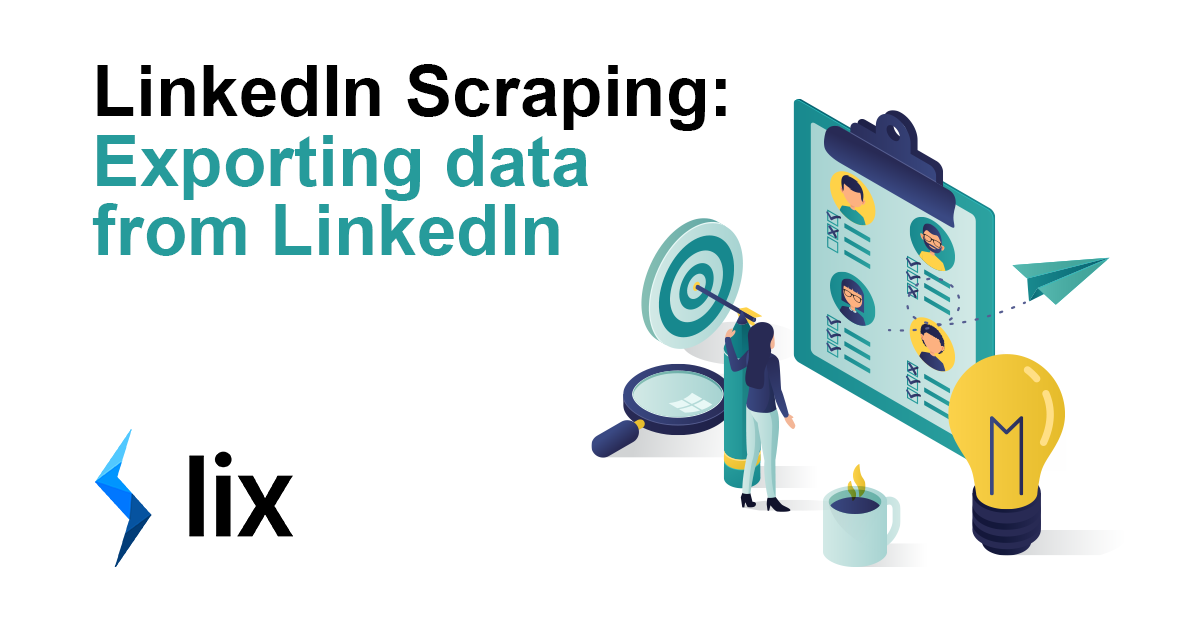With 830 million members, 53 million companies and more than 100 million active job listings, LinkedIn is the largest store of public business data in history. The problem is, how do you extract that LinkedIn data to make use of it? Whether you’re a salesperson looking to prospect, a market intelligence professional finding intel or an academic performing research – LinkedIn scraping can help you get the data you need, in the format you need it.
What is scraping?
Data scraping is a method of data collection in which a computer program extracts data from websites and web pages. The purpose of this technique is to obtain otherwise inaccessible or unstructured data. This can be useful for businesses looking to use the information they collect in sales and marketing campaigns, competitive and market intelligence, or even just for their own purposes (such as tracking sales).
How can I use scraped data?
Understanding customers
Data scraping can provide insight into an individual’s current role, organisation, education, interests, skills and a whole host of information that might be useful for a business. It can help you to form an ideal customer profile, or identify individual targets for prospecting. It can also help you to better understand groups, industries and verticals. For example, LinkedIn scraping might allow a company selling training courses to discover how many individuals with a specific job title already have a qualification.
Understanding competitors
Extracting competitor data can help you to learn about their business structure, products and services, pricing strategies, marketing campaigns, hiring patterns and more – all of which could be useful in improving your own company’s performance. Scraping a competitor’s job postings, for example, could help you to determine which departments they are investing in and how fast they are growing. This is also useful information for investors.
LinkedIn Scraping
You can scrape data from LinkedIn search results and also directly from profiles – as long as those profiles aren’t private. The easiest way to do this is with a LinkedIn scraper tool, like Lix. LinkedIn scraping with Lix is as easy as performing a search, setting your filters and choosing your export options. You can export People, Profile, Companies and Jobs data in minutes, saving you time and money.
Let’s take a look at some of the data you can export from LinkedIn using Lix:
Search Results: People, Companies and Jobs
The most common form of LinkedIn scraping happens on search result pages. This is the page you land on when you type a keyword into the search bar on LinkedIn.

These are great for scraping, because they’re packed with lots of data per page. This is is important because LinkedIn have some rules about how many pages you can view in a day. In order to comply with their fair usage policies, it’s advised to not view more than 1,000 pages in a day. If you’re exporting profile data, this means you can export a maximum of 1,000 profiles in a day. However, standard LinkedIn search results show 10 results per page – allowing you up to 10,000 rows of data per day. Sales Navigator gives you 25 results per page, giving you a potential 25,000 scraped rows per day.
Currently, Lix can export People, Companies and Jobs results, but we will be adding other options in the future. Scraping these pages is super simple, here’s a 40 second video showing you how it works:
Export LinkedIn connections
Exporting LinkedIn connections is another popular form of LinkedIn scraping. You may want to export your own connections, to keep a record of your network or perhaps add them to a CRM.
There are many instances where you may want to export someone else’s connections, too. This is possible as long as you are connected to the individual whose connections you’d like to scrape. This is due to data privacy laws and there is no way around this – other than connecting with that person.
Want to know more about exporting LinkedIn connections? Here’s a popular article we published.
Export LinkedIn profile data
A complete LinkedIn profile is packed with data. Data this is extremely important in the recruiting process, or for market intelligence research. It can also be a great source of icebreakers and deep dive info on sales prospects.
Exporting LinkedIn profiles is a little more complicated than exporting search results, because you view far more individual pages in a short space of time. There is also a lot more data to collect for each result!
Lix’s Profile Enrichment tool works in conjunction with Sales Navigator, because Sales Navigator users can view more profiles per day without hitting LinkedIn’s limits.
The process itself is simple – export a list of individuals from a Leads search and then enrich that search in the Profile Enrichment area of your Lix dashboard. You get 50 free enrichments a month, so do give it a try and see what data you can get!
LinkedIn scraping allows you to export, works with and glean insights from the huge store of public data on LinkedIn. According to our users, Lix is the fastest and easiest way to do that! If you’d like to try it for yourself we give you 1,000 rows of data, 50 profile enrichments and 50 valid emails every single month.
